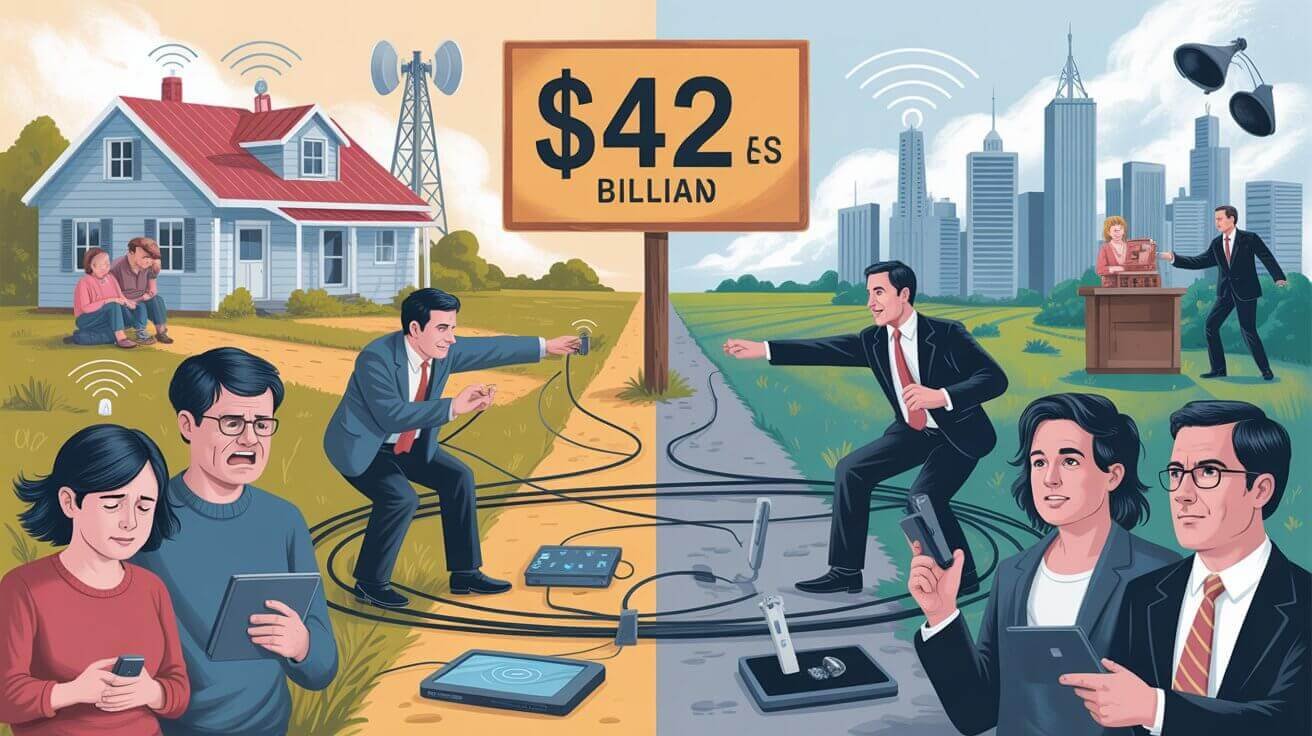I’ve been watching this story unfold for months, and honestly, it’s gotten more complicated than anyone expected. The rural broadband digital divide isn’t just about slow internet anymore—it’s become a full-blown political battleground where states, internet providers, and the federal government are fighting over who gets to decide what “affordable” actually means.
Just last week, the Trump administration essentially told states: “Don’t you dare tell internet companies what to charge poor families, or we’ll take away your $42 billion in broadband funding.” Moreover, this move affects the rural broadband digital divide in ways that could impact millions of Americans for decades to come.
What’s Really Happening with BEAD and State Authority
The Broadband Equity, Access, and Deployment (BEAD) program started as a bipartisan effort to finally solve America’s internet access problem. Congress allocated $42.5 billion to help states expand broadband to underserved areas, particularly rural communities where internet access remains spotty or nonexistent.
However, things got complicated when states like New York and California started passing laws requiring internet service providers to offer specific low-cost plans. New York, for example, requires ISPs with more than 20,000 customers to offer $15 broadband plans with minimum 25Mbps download speeds to low-income customers.
The Trump administration has now warned states they’ll lose BEAD funding if they try to dictate rates, effectively handing internet providers the power to define what constitutes “affordable” service. This decision directly impacts the rural broadband digital divide by removing state-level protections for low-income consumers.
The Immediate Casualties
California provides the most stark example of how this policy shift affects real people. The state was working on legislation requiring $15 broadband plans when federal officials threatened to withhold $1.86 billion in BEAD funds. Instead of fighting, California backed down and withdrew the bill.
Think about what this means: A state with some of the highest living costs in America just gave up its ability to ensure affordable internet for its residents because the federal government threatened to take away funding meant to help those same residents get connected.
Understanding the Rural Broadband Digital Divide Impact
The Numbers Tell a Harsh Story
The rural broadband digital divide affects real families in measurable ways. According to recent research, 43% of adults with household incomes under $30,000 don’t have broadband internet at home, compared to only 8% of those making over $75,000 annually.
Furthermore, the problem gets worse in rural areas where the rural broadband digital divide intersects with geographic isolation. In Alpine County, California, for instance, most of the 1,100 residents still rely on phone lines for internet access and can’t afford high-speed connections. Rather than renewing driver’s licenses online, many residents drive 30 miles to the closest DMV office.
The “Homework Gap” Reality
The rural broadband digital divide creates what educators call the “homework gap.” Approximately 35% of lower-income households with school-age children lack broadband internet at home, making it impossible for kids to complete digital assignments or participate in online learning.
During the COVID-19 pandemic, this gap became a chasm. Parents with lower incomes were significantly more likely to say their children faced digital obstacles to remote learning. Even now, as schools increasingly rely on digital tools, students in areas affected by the rural broadband digital divide find themselves at a severe disadvantage.
How ISPs and States Are Choosing Sides
The Provider Perspective
Internet service providers argue that government price mandates discourage investment in network infrastructure. They claim that forced low-cost plans make it financially impossible to expand into rural areas where deployment costs are highest and customer density is lowest.
USTelecom, representing major broadband providers, has lobbied extensively for the flexibility to set their own pricing. Their position is that market-driven pricing ensures sustainable networks and encourages the investment needed to close the rural broadband digital divide.
Additionally, ISPs point out that building infrastructure in rural areas can cost 10 times more per customer than in urban areas. They argue that without the ability to charge profitable rates to some customers, they can’t afford to serve remote communities at all.
State Governments Fight Back
States see the situation differently. They argue that without pricing requirements, ISPs will simply pocket government subsidies while charging whatever the market will bear. Since many rural areas have only one or two internet providers, residents have little choice but to pay high prices or go without service.
Every state that submitted digital equity plans identified broadband affordability as the primary barrier to closing the digital divide. States know their residents need affordable options, but now they’re being told they can’t mandate them.
Some states are trying workarounds. California plans to develop a state-led affordable broadband program, while Minnesota is exploring models for a statewide subsidy program. However, these alternatives cost money that states may not have.
Real-World Consequences for Rural Communities
Beyond Internet Access
The rural broadband digital divide affects much more than just web browsing or entertainment streaming. Rural residents need reliable internet for:
- Healthcare: Telemedicine appointments that could save hours of driving
- Education: Online college courses and professional development
- Employment: Remote work opportunities that could revitalize rural economies
- Government services: Online tax filing, benefit applications, and civic participation
- Emergency services: Enhanced 911 systems and disaster communications
Economic Development at Risk
Rural communities often see broadband expansion as essential for economic survival. Young families move away because they can’t work remotely. Businesses can’t compete without reliable internet. Agricultural operations struggle to adopt precision farming technologies.
Conversely, areas that successfully address the rural broadband digital divide often see new business development, population growth, and increased property values. The stakes couldn’t be higher for these communities.
The Technology and Timeline Reality Check
Why Fiber vs. Satellite Matters
The Trump administration’s changes to BEAD also favor satellite internet providers like Starlink over traditional fiber networks. While satellite can be deployed faster, it typically offers less reliable service and higher latency than fiber connections.
For rural communities dealing with the rural broadband digital divide, this technological choice has long-term implications. Fiber networks can last 25-30 years and handle unlimited capacity growth. Satellite systems may become congested as more users come online.
Under the revised rules, Starlink could receive $10-20 billion in BEAD funding, up from $4.1 billion under the original fiber-focused approach. This represents a massive shift in how America builds its internet infrastructure.
The Implementation Challenge
Even without political complications, the BEAD program faces significant implementation challenges. Most states are still in the planning phase three years after the program launched. Complex application processes, mapping disputes, and environmental reviews have slowed progress considerably.
Now, with federal rule changes requiring states to restart parts of their planning process, further delays seem inevitable. For rural communities affected by the rural broadband digital divide, this means waiting even longer for promised improvements.
What This Means for Your Community
If You Live in a Rural Area
The policy changes affecting the rural broadband digital divide will likely mean:
- Higher prices for internet service, especially for low-income households
- Potentially faster deployment of satellite internet options
- Less state-level protection against price gouging
- Continued uncertainty about when reliable service will arrive
Rural residents should contact their state broadband offices to understand how these changes affect local plans. Many states are still determining how to navigate the new federal requirements.
If You’re a State or Local Official
State and local officials need to understand that the landscape has fundamentally changed. Previous strategies for addressing the rural broadband digital divide may no longer be viable under federal rules.
Consider alternative approaches like:
- Municipal broadband networks where legally permitted
- Public-private partnerships with different financial structures
- State-funded affordability programs independent of federal rules
- Regional cooperation agreements to increase bargaining power
If You’re an Advocate
Consumer advocacy groups are calling the changes a betrayal of rural communities. However, organized advocacy can still influence implementation. Key strategies include:
- Documenting the real-world impacts of pricing decisions on families
- Engaging in state-level planning processes that remain open to public input
- Supporting legal challenges to federal policy changes
- Building coalitions between rural and urban communities affected by digital inequity
Looking Ahead: The Future of Rural Internet Access
Political Uncertainty
The federal approach to broadband could change significantly depending on future elections and policy priorities. States that maintain their own broadband programs may be better positioned to adapt to federal policy shifts.
Meanwhile, the rural broadband digital divide continues affecting millions of Americans who can’t wait for politicians to resolve their differences. These communities need solutions now, regardless of the ongoing policy debates.
Technology Evolution
Emerging technologies like low earth orbit satellites, 5G fixed wireless, and improved fiber deployment techniques could eventually make the rural broadband digital divide obsolete. However, these technologies must be deployed equitably and affordably to benefit everyone.
The key question is whether market forces alone will ensure equitable access, or whether government intervention remains necessary to serve less profitable rural markets.
Economic Pressures
The end of the Affordable Connectivity Program in June 2024 already eliminated $30-75 monthly internet discounts for over 23 million households. Without state-level pricing protections, low-income families in rural areas face mounting pressure from multiple directions.
Unless something changes, the rural broadband digital divide could actually worsen despite billions in federal infrastructure investment.
The Bottom Line: What Needs to Happen
The fight over who controls internet pricing represents a fundamental disagreement about government’s role in ensuring affordable access to essential services. However, while politicians and providers argue, real families go without internet access they need for work, school, and healthcare.
The current approach treats the rural broadband digital divide as primarily an infrastructure problem that can be solved by building more networks. But infrastructure without affordability protections may simply create faster, more expensive ways for rural Americans to remain disconnected.
Effective solutions require addressing both access and affordability simultaneously. This means finding ways for states, providers, and federal agencies to work together rather than using funding as a weapon in political battles.
Rural communities deserve better than being caught in the middle of this power struggle. They need reliable, affordable internet access that helps their local economies thrive and keeps their families connected to opportunities in the broader digital economy.
The $42 billion question isn’t just about money—it’s about whether America will finally solve the rural broadband digital divide or create new barriers that keep rural communities on the wrong side of the digital economy for another generation.








